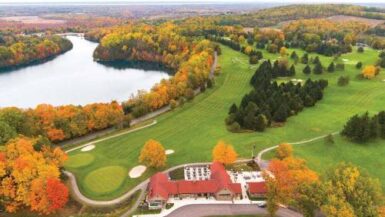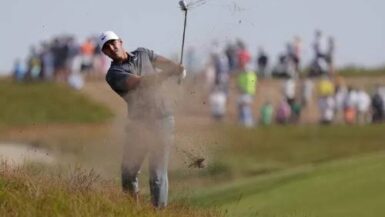
UNIVERSITY PLACE, WA – Chambers Bay Co-architect Bruce Charlton smiles and claps his hands as a stat appears on the TV broadcast of the U.S. Open listing the brutish, uphill, 508-yard, par-4 seventh hole as the hardest hole on the golf course thus far in the tournament, a 4.43 stroke average as we go to press.
“We wanted there to be swing holes. We wanted the excitement of players shooting up and down the leaderboard,” he explains. “Many of the changes we made to the course after the 2010 U.S. Amateur were meant to do just that, and thankfully we are seeing exactly that – great players are shooting good scores, while at the same time, the course is holding its own against the field.”
Excitement, swings in scoring, and a mercurial rising and falling up and down the leaderboard – that’s what the U.S. Open usually lacks. Golf’s toughest test is sometimes golf’s most plodding test, with the winner often being the player who percolated the least down the leaderboard rather than rose up to win in dramatic fashion. But this year’s U.S. Open at Chambers Bay has been called a British Open in June, and the sentiment is true on many levels, not the least of which is that there are as many birdie opportunities as there are minefields of unexploded double bogeys. We will see swings this year, and that means drama.
“We designed the swing holes to come early in the round and late in the round,” Charlton points out. Holes one and two are a perfect example. On the days when one plays a par-5 you can come out of the gate 2-under with an eagle. Then number two is another excellent birdie op; it’s an easy driving hole with a straightforward green. They’ll have a short club in their hand if they hit the fairway, and can get to 3-under after two holes!” he concludes, smiling.
Interestingly, Tiger Woods bogeyed both of those holes to open his round.
“How did he bogey both one and two?” asked Robert Trent Jones, Jr. when he saw the scoreboard. “That’s hard to do…”

But soon, players enter what Chambers Bay staff like to call the “Bermuda Triangle” – the teeth of the front nine, holes 4-7, all gargantuan par-4s, (495 yards, 488 yards, 495 yards, and 508 yards, for those of you scoring at home), the first and last of which are dead uphill and into a blistering crosswind. Four is particularly difficult. Uphill all the way to the green, the axis of which is perpendicular to the line of play, and which is guarded by one of the wildest and deepest bunker complexes on the course.
“You see the opposite side of the coin on those holes. You can go backwards quickly” Charlton continued. “On five you have a big landing area for your drive, but you have to be in exactly the right place to attack the pin on that boomerang green.”
Then there’s the wild sixth, with towering dunes flanking the fairway and narrow, but deep trench bunkers flanking the green, must large enough for an angry pro and his wedge.
“I call six the ‘Egyptian Hole,'” Jones states animatedly. “There are mummy’s tombs, pyramids with the tops chopped off, on the sides of the fairway, huge hillocks on either side. “If you’re not in the right spot, you have a blind or semi-blind shot in.”
Then Jones becomes his usual puckish self and cracks a joke. “If you make a birdie on six, the mummy’s curse will kick in and he’ll wake up and chase you around the golf course.”
After the laughter dies down, Charlton continues the analysis.
“Seven is one of my favorite drives on the course. A true Cape Hole, classic risk-reward, bite off as much of the diagonal bunker as you dare and you may have a 3-club advantage over someone who plays more safely,” he explains. “But it’s the most elevated approach on the golf course and the false front is so dangerous.”
Meanwhile Dustin Johnson played those holes 3-under. That’s why he’s the co-leader, along with Henrik Stenson.
Then the course relents ever so slightly with the par-5 eighth.
“Three is in play there,” Charlton admits. “It’s straightforward with a receptive green, and players will have a wedge on their hands.”
Eight is also one of the holes that was changed after the 2010 U.S. Amateur. Jones and Charlton smoothed the approach to the green so that second shots actually scoot forward rather than scattering all across the fairway and into the rough.
12 is another potential birdie op…if you hit a good drive. But the most severe green on the course passes out three-putts like candy on Halloween.
“Along with 18, it’s the hardest green on the course, but since it’s one of the shortest holes as well, it works,” Jones confided. He’s right: the shorter the hole, the sexier you can make it. Often times, Jones can say more in 300 yards than other architects can say in 500.

The finish is wild and unpredictable.
“We designed 15-18 to potentially swing a couple shots on each hole,” Charlton states. “And as such, Mike Davis has all sorts of options with the flexibility of the ribbon tees. We want things to happen and players to makes moves up or down at the end of the round.
The iconic 15th, can from 140 to 246, the 16th can be as short as 300 yards, but features the narrowest green on the course, and 18 will rotate between being a par-4 and par-5 over the course of the weekend.
As for the low scores today, don’t fret, purists. Today was the “tourist” hole locations. Get everyone off to a friendly start. The tournament will get progressively harder as the week goes on.
“I’m happy with the way the course is playing and set up,” Charlton concluded. “It proved nay-sayers wrong when they said it was too fast and firm. We’re seeing players spin the ball on the greens, and good shots are being rewarded – which is exactly what’s supposed to happen.”
“And bad shots are punished,” Jones concluded. “The best in the World have risen to the top of the leaderboard at the toughest test in golf.”
So to all the crybabies out there who are bellyaching, you have nothing to say. Two guys shot 65, and three fired 66s. It can’t be all that unfair or “non-traditional.” Besides, what’s a U.S. Open without bellyaching? A St. Jude Classic. Sorry, guys. That was last week.





